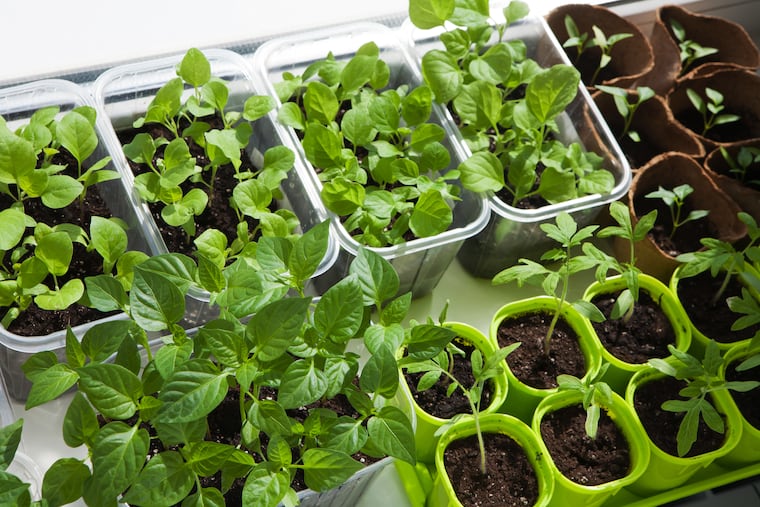Itching to garden? Here’s when it’s safe to plant your favorite vegetables
“Plants want to have warm feet, not cold feet. Soil temperature is the most important thing for planting.”

Offering fatal temptation to shoppers, the very first shipment of young lavender, rosemary, and parsley plants were among those stocked at Lowe’s on March 6.
Buying plants so early is a big risk in a month when conditions this year have varied from sunny days in the 70s to overnight lows in the single digits.
“Everything has a season,” Plymouth Meeting Lowe’s sales associate Susan Longenberger said. “You can put plants out early, but then you have to babysit them. That means you need a cold frame.”
A cold frame is a garden structure that creates a cozy microclimate to help plants weather cold nights in the spring or fall.
Until early May without that infrastructure in place, she said, “You’ll be watching the temperatures for frost every night and throwing a blanket on top of the plants.”
So when can you safely plant?
That depends.
The naked skin test
Just like people, plants like to be comfortable. For tomato lovers, consider what’s called the “bare bottom” test. That’s when naked skin will not shiver when in contact with the ground.
To test for this, hard-core gardeners poke a digital meat thermometer in the dirt. If results stand 65 degrees or warmer, tomatoes and peppers and other heat-loving vegetables can thrive. That’s because these Latin American descendants cannot chemically extract vital phosphorus from frigid soil. If you plant tomatoes or peppers before the soil reaches at least 60 degrees (and that is pushing it), experts warn certain plants might be stunted and bear little fruit.
“Plants want to have warm feet, not cold feet,” said Erin Kinley, master garden coordinator for the Philadelphia area for Penn State Extension. “Soil temperature is the most important thing for planting.”
» READ MORE: Saving and replanting seeds can expand gardens and preserve cultural crops
Growers itching to dig now can tuck in spinach, lettuce and cabbage family seeds or plants such as broccoli, cauliflower, Brussels sprouts, kale, and collard greens.
Unlike tomatoes and peppers, such “cold crops” evolved in the planet’s chillier northern latitudes to take up critical nutrients from soil, she said.
Pea seeds, Kinley added, will germinate in soil temperatures as low as 40 degrees.
“That is why we say you can plant your peas on St. Patrick’s Day,” Kinley said.
That’s more than two weeks before the April 2 average last frost date for the Philadelphia region, according to an analysis of National Weather Service by Inquirer weather reporter Anthony R. Wood.
And while fickle air might warm the skin one day and then inflict deadly frost the next, soil holds memory. By the Ides (that’s Latin for the “middle”) of March, longer days of advancing sunshine have been steadily warming the earth.
Killer frost
Since most home gardeners don’t stock a digital meat thermometer in the garden shed, average air temperatures are more commonly used as a proxy for the best times to plant.
Air temperature matters because freezing inflicts swift death on plants by permanently crippling delicate leaf structures. That’s why shielding tender sprouts overnight, with a sheet or blanket, can raise temperatures just enough to keep them alive another day.
But don’t smother fragile seedlings with hastily thrown coverings, Longenberger said. If frost threatens, she said, make ad hoc structures to create a temporary overnight cocoon.
Microclimates
In heavy urban areas, brick, concrete and asphalt absorb solar radiation to make urban Philadelphia its own microclimate. Within any yard, Kinley said, smaller microclimates abound as conditions of heat-stealing wind and shade vary.
“In Pottstown where I live, I can plant stuff now in a sunny side of our back porch, as opposed to our east-facing patio,” Kinley said. “Microclimates are really big when you are gardening in urban and suburban areas.”
Some of the best microclimate patches can be found in south-facing beds shielded from wind and snuggled up against a sunny wall.
» READ MORE: How to turn your Philly rowhouse backyard into a vegetable garden on the cheap
As a result of the overall microclimate “heat island” effect, city gardeners may consider shifting the region’s average local last frost date of April 2 three or four days back to March 29 to 30 for assured survival of cold crops.
Prudent planters in less-paved suburbs and exurbs here, can plan for frost threat to persist longer, up to three to four days after April 2, according to an Inquirer analysis of decades of weather data.
Tomato time
The month of May is named for “Maia, the Roman goddess of growth,” according to the 2022 edition of Harris’ Farmer’s Almanac.
Around Mother’s Day, this year on May 8, sow seed for melons, squash, cucumbers, pumpkins, corn, okra and more. By mid-May, the sun will be shining nearly 15 hours a day. As a result, the dirt will warm to at least 65 degrees, Kinley said.
As a result, May heralds truly cozy soil temperatures and is the best time to buy and bed young tomato, basil, and pepper plants. To be precise, the Farmer’s Almanac recommends planting tomatoes this year on May 17.